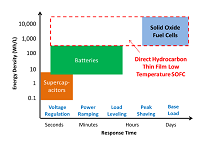Hybrid Fuel Cell-Battery System

Technology Description:
SiEnergy Systems is developing a hybrid electrochemical system that uses a multi-functional electrode to allow the cell to perform as both a fuel cell and a battery, a capability that does not exist today. A fuel cell can convert chemical energy stored in domestically abundant natural gas to electrical energy at high efficiency, but adoption of these technologies has been slow due to high cost and limited functionality. SiEnergy’s design would expand the functional capability of a fuel cell to two modes: fuel cell mode and battery mode. In fuel cell mode, non-precious metal catalysts are integrated at the cell’s anode to react directly with hydrocarbons such as the methane found in natural gas. In battery mode, the system will provide storage capability that offers faster response to changes in power demand compared to a standard fuel cell. SiEnergy’s technology will operate at relatively low temperatures of 300-500ºC, which makes the system more durable than existing high-temperature fuel cells.
Potential Impact:
If successful, SiEnergy’s hybrid fuel cell-battery will operate at intermediate temperatures with high efficiency, high energy density, and quick response time while representing a dramatic improvement over the functionality of existing fuel cells.
Security:
Enabling more efficient use of natural gas for power generation provides a reliable alternative to other fuel sources—a broader fuel portfolio means more energy security.
Environment:
Natural gas produces roughly half the carbon dioxide emissions of coal, making it an environmentally friendly alternative to existing sources of power generation.
Economy:
Distributed generation technologies would reduce costs associated with power losses compared to centralized power stations and provide lower operating costs due to peak shaving.
Contact
ARPA-E Program Director:
Dr. Paul Albertus
Project Contact:
Dr. Masaru Tsuchiya
Press and General Inquiries Email:
ARPA-E-Comms@hq.doe.gov
Project Contact Email:
masaru.tsuchiya@sienergysystems.com
Partners
Harvard University
Related Projects
Release Date:
11/25/2013
